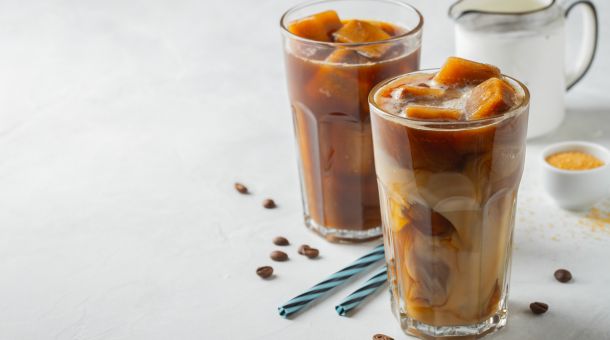Whether you’re a coffee aficionado or just someone who enjoys the occasional cup, it’s time to explore the delightful world of cold brew coffee.
While cold brew has been around for a while, its recent surge in popularity in Singapore and other countries has piqued the interest of many.
As more and more people discover the unique flavors of cold brew, their curiosity about this chilled coffee concoction grows.
With this rising interest, there has been a corresponding increase in research dedicated to this beverage. In this article, we’ll share some fascinating and lesser-known facts and benefits of cold brew coffee, providing you with insights into its world. So, let’s delve into the intriguing realm of cold brew coffee!
What Is Cold Brew Coffee?

Cold Brew coffee is a unique coffee preparation method that involves steeping coffee beans in cold water for an extended period, typically 12 to 24 hours.
This extended steeping allows for the extraction of flavor, caffeine, and sugars from the coffee beans. The process is designed to produce coffee that is not bitter, as the soluble compounds responsible for the bitterness found in hot coffee are less easily released in cold water.
To achieve the desired flavor and aroma, a higher ratio of coffee grounds to water and a longer infusion time are used.
It’s important to note that Cold Brew coffee is distinct from regular iced coffee, which is made by simply pouring hot brewed coffee over ice.
5 THINGS TO KNOW ABOUT COLD BREW COFFEE
1: Boosts Metabolism
For those aiming to rev up their metabolism, cold brew coffee offers a helping hand. Caffeine, a known metabolism booster, can increase your calorie burn during physical activity and even at rest.
Research indicates that caffeine can elevate metabolism by approximately 11%. Cold brew coffee, with its high caffeine content compared to other coffee types, can become a valuable ally in your quest to boost your metabolism.
May Lower Type 2 Diabetes Risk
Type 2 diabetes risk reduction is another potential benefit of coffee consumption. Studies suggest that consuming four to six cups of coffee daily may lower the risk of developing Type 2 diabetes.
Coffee’s antioxidant content, particularly chlorogenic acids, plays a role in this. Additionally, cold brew coffee aids in regulating gut peptides, which contribute to digestion control and blood sugar stability.
Potential Alzheimer’s Disease Risk Reduction
Cold brew coffee, like other coffee varieties, contains compounds that have been associated with a reduced risk of neurodegenerative diseases like Alzheimer’s.
The caffeine in coffee stimulates the nervous system, positively influencing brain function, and potentially contributing to cognitive health.
Natural Sweetness
If you prefer a sweeter coffee but want to avoid adding sugar, cold brew coffee might be your go-to choice. Its unique brewing process results in a naturally sweeter taste compared to hot-brewed coffee.
Cold brewing minimizes acidity levels, mellowing the oils responsible for bitterness and enhancing the coffee’s inherent sweetness.
This method also highlights the distinct flavor profiles of various coffee beans, offering a diverse range of flavor options.
Higher Caffeine Content
Cold brew coffee boasts a higher caffeine content than many other coffee types due to its extended steeping process and higher coffee-to-water ratio.
However, it’s important to note that this high caffeine concentration is typically found in the cold brew concentrate.
To enjoy a milder coffee, the concentrate is often diluted with water, cream, or milk, making it a versatile and customizable choice for caffeine enthusiasts.
How is a cold brew made?
Cold brew coffee is made through a simple yet time-intensive process. Here’s a basic guide on how to make cold-brew coffee:
Ingredients and Equipment:
- Coarsely ground coffee beans
- Cold, filtered water
- A large jar or pitcher
- A fine-mesh sieve, coffee filter, or a specialized cold brew coffee maker
- Optional: flavorings like vanilla extract, spices, or sweeteners
- Ice (if you want to serve it iced)
Instructions:
Coffee-to-Water Ratio:
For a standard cold brew concentrate, use a coffee-to-water ratio of around 1:4 or 1:5. This means one part coffee to four or five parts water. You can adjust this ratio to your taste preferences.
Combine Coffee and Water:
- In your large jar or pitcher, add the coarsely ground coffee beans.
- Pour the cold, filtered water over the coffee grounds. Make sure all the coffee grounds are saturated by stirring gently. You can also add any optional flavorings or spices at this point.
Steeping:
Cover the jar or pitcher and let it steep at room temperature for an extended period, typically 12 to 24 hours.
The steeping time allows the coffee’s flavors to fully develop. You can choose the steeping time based on your preference for strength and flavor.
Filtering:
After the steeping period, you need to filter out the coffee grounds. You can do this by using a fine-mesh sieve, a coffee filter, or a specialized cold-brew coffee maker.
If using a sieve, you may need to strain the coffee multiple times to remove as many fine grounds as possible.
Serving:
Once filtered, you can dilute the cold brew concentrate with water or milk to achieve your desired coffee strength.
Cold brew is highly concentrated, so it’s typically diluted with one to two parts water or milk. You can also add ice to make an iced cold brew.
Enjoy:
Serve your cold brew coffee over ice, add sweeteners or flavorings if desired, and savor the rich, smooth, and less acidic coffee that you’ve created.
Remember that cold brew coffee can be stored in the refrigerator for several days, making it a convenient option for enjoying a refreshing cup of coffee whenever you like.
Cold brew vs. iced coffee
A short table highlighting the key differences between Cold Brew and Iced Coffee:
| Aspect | Cold Brew | Iced Coffee |
| Brewing Method | Steeping coffee grounds in cold water for an extended period (12-24 hours). | Brewing hot coffee and then cooling it down with ice. |
| Flavor Profile | Smooth, mellow, less acidic, and naturally sweeter. | Similar to traditional hot coffee but cooled, retaining its acidity. |
| Caffeine Content | Higher caffeine concentration in the concentrate. | Lower caffeine concentration, similar to regular hot coffee. |
| Strength | Concentrated; typically diluted before serving. | Usually served as-is over ice. |
| Brewing Time | Requires an extended steeping time. | Brewed quickly and then cooled. |
| Customization | Easily customizable with added water, milk, and flavorings. | Customizable with milk or sweeteners. |
| Serving Style | Typically served over ice or diluted with water or milk. | Served directly over ice. |
| Shelf Life | Can be stored in the refrigerator for several days. | Best when served fresh, as it may lose flavor over time. |
| Cold vs. Hot Brew | Made with cold water throughout the brewing process. | Starts as hot coffee and is cooled down. |
FAQ
Why drink cold brew?
Cold brew is an excellent choice for those seeking a smooth, less acidic, and naturally sweeter coffee experience, making it perfect for a refreshing drink, especially in hot weather.
Is cold brew stronger?
Cold brew can be stronger in terms of caffeine concentration, but it’s usually served in a diluted form by mixing it with water or milk.
How long does cold brew last?
Cold brew can last in the refrigerator for several days, maintaining its flavor and quality if stored properly in an airtight container.
Conclusion
Cold brew coffee offers a delightful and refreshing alternative to traditional hot coffee. With its unique flavor profile, versatility, and potential health benefits, it has gained a dedicated following among coffee enthusiasts.
Whether you’re seeking a less acidic, naturally sweeter coffee or a way to beat the heat, cold brew is a satisfying choice that can be enjoyed with ease, thanks to its longer shelf life when stored properly.
So, consider giving cold brew a try and discover the cool and enticing world of this chilled coffee delight.

